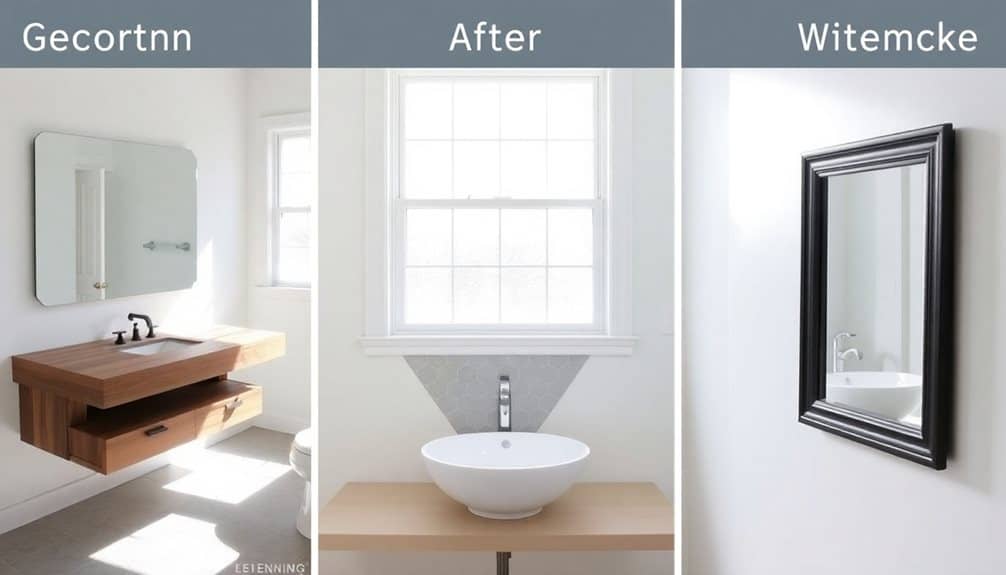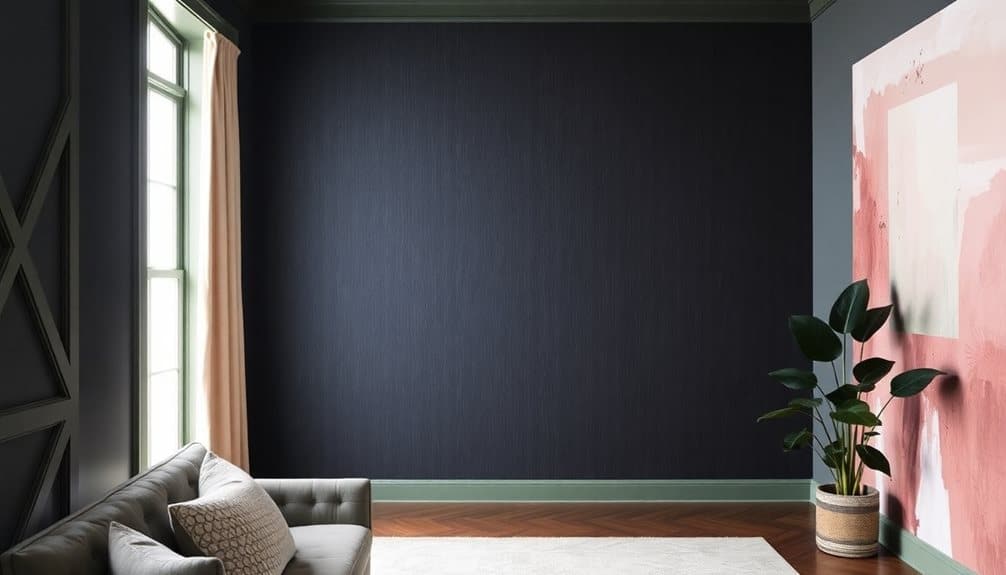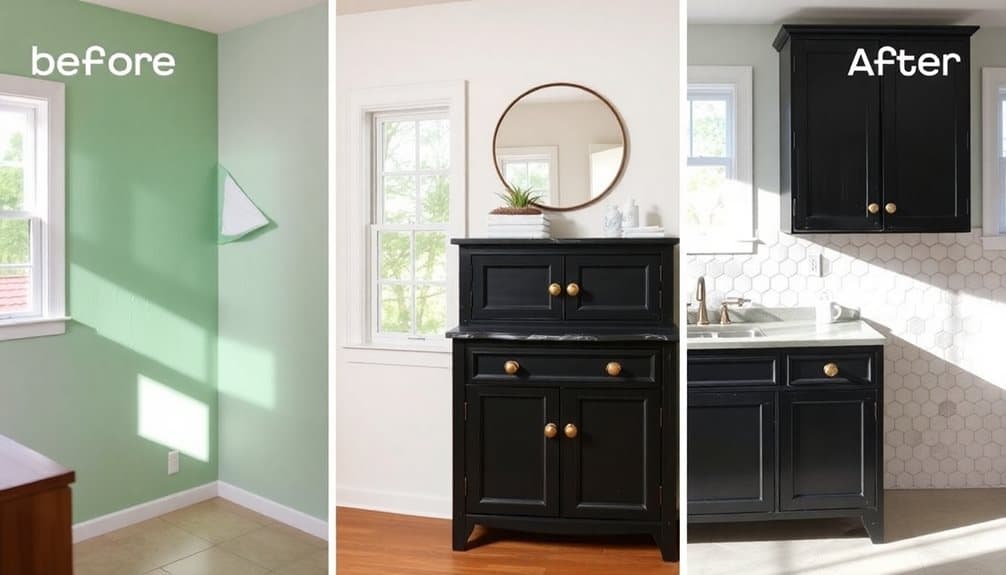This website contains affiliate links. Some products are gifted by the brand to test. As an Amazon Associate, I earn from qualifying purchases. The content on this website was created with the help of AI.
You can transform your living space with three high-impact DIY projects under $500. Refresh your interior with a paint and hardware update, using low-VOC latex paint and modern cabinet pulls for a polished look. Create a modern bathroom makeover by refinishing your vanity, upgrading hardware, and installing a frameless mirror and LED lighting. Or install a statement wall using peel-and-stick wallpaper, board-and-batten wainscoting, or a geometric paint design for dramatic impact. Each project requires proper preparation and basic tools, but you’ll find detailed steps and expert tips to guarantee professional-quality results in your renovation journey.
Key Takeaways
- Transform a bathroom with a new vanity finish, modern hardware, frameless mirror, and LED lighting for under $500.
- Create a statement wall using peel-and-stick wallpaper or board-and-batten wainscoting, ranging from $100-300 in materials.
- Update kitchen appearance with fresh cabinet hardware and paint, costing $150-250 for supplies and materials.
- Install geometric paint designs using painter’s tape and semi-gloss paint for a modern accent wall under $100.
- Replace outdated bathroom fixtures including curved shower rod, faucet, and heavy shower curtain for about $200.
Paint and Hardware Updates

When it comes to high-impact yet budget-friendly renovations, paint and hardware updates deliver the most dramatic transformation for your investment. With a budget of $150-250 for premium paint and supplies, you’ll achieve professional results by using proper surface preparation techniques and quality materials like TSP cleaner, sandpaper, and painter’s tape.
For walls, choose low-VOC latex paint with an eggshell finish for durability and washability. You’ll need one gallon per 400 square feet of coverage, plus 20% extra for touch-ups. For trim and doors, opt for semi-gloss paint that resists scuffs and moisture. Consider using paint with built-in primer to reduce total coats needed.
Hardware updates complement fresh paint perfectly, with cabinet pulls and knobs ranging from $2-10 each. Select brushed nickel or matte black finishes for contemporary appeal, or vintage-inspired brass for traditional spaces. Replace dated light switch plates, door handles, and hinges to maintain consistency throughout. Install new hardware using a cabinet hardware jig to guarantee precise alignment and professional results. Don’t forget to properly prep existing hardware holes and fill any that won’t be reused with wood filler before painting. For maximum organization in bathrooms, consider adding rust-resistant shower caddies to store toiletries and keep surfaces clutter-free.
Modern Bathroom Makeover

Ready to transform your dated bathroom into a modern oasis? For under $500, you can achieve a high-impact makeover by focusing on key elements that deliver maximum visual return on investment.
Start by refinishing your existing vanity with moisture-resistant paint ($35) and installing modern brushed nickel hardware ($25). Replace your builder-grade mirror with a frameless beveled option ($125) and upgrade your faucet to a single-handle modern design ($85). Install LED vanity lighting ($75) to enhance visibility and create ambiance.
For the shower area, remove old caulking and apply fresh silicone sealant ($15). Install a curved shower rod ($45) and replace your basic shower head with a rainfall model ($65). Don’t forget to upgrade your shower curtain to a heavy-weight fabric option ($25).
Complete the transformation by mounting floating shelves ($45) for vertical storage and installing a new toilet paper holder and towel bars in matching finishes ($35). You’ll also want to deep clean or re-grout tile lines ($20) to restore their original appearance. These strategic upgrades create a cohesive, contemporary look while maintaining a strict budget. Consider adding a 6-tier towel rack that combines metal and wood elements for additional storage and a modern rustic aesthetic that maximizes vertical space.
Statement Wall Design

A statement wall serves as the perfect focal point for transforming any room’s visual impact without breaking your budget. You’ll need to select one wall that’s most visible when entering the space, typically the one behind a bed, sofa, or dining area.
For under $500, you’ve got several high-impact options. Premium peel-and-stick wallpaper ($100-200) offers intricate patterns and textures without the commitment of traditional wallpaper. Board-and-batten wainscoting ($200-300) creates architectural interest using MDF boards, construction adhesive, and paint. A geometric paint design using painter’s tape ($75-100) delivers modern sophistication when you combine two or three complementary colors.
Before installation, prep your wall by filling holes, sanding rough spots, and cleaning thoroughly with TSP solution. If you’re using wallpaper, check that your wall texture isn’t too aggressive – orange peel texture is acceptable, but heavy textures require skimming. For paint projects, invest in quality materials like Frog Tape and semi-gloss paint for crisp lines. With board-and-batten, use a laser level to guarantee precise alignment and pre-paint your MDF to prevent swelling from moisture. Similar to adjustable hive stands, proper stability and level installation are crucial for achieving professional-looking results that will last for years.
Frequently Asked Questions
Do I Need Special Permits for Small DIY Renovation Projects?
You’ll typically need permits for projects that involve structural changes, electrical work, plumbing, or additions to your property, regardless of size. Check with your local building department, as requirements vary by jurisdiction. Many cosmetic updates like painting, flooring, or cabinet hardware don’t require permits. However, even minor modifications to load-bearing walls, electrical circuits, or water lines legally require proper permitting.
How Long Should I Wait Between Renovation Projects in the Same Room?
You’ll want to space out renovation projects in the same room by at least 2-4 weeks to allow proper curing and settling. Paint needs 14 days to fully cure, while caulk requires 24-48 hours. If you’ve done structural work or installed drywall, wait 30 days before starting new projects to guarantee moisture levels stabilize and materials properly set. This prevents complications between overlapping renovations.
Which Renovation Projects Add the Most Value to My Home?
Like a wise investor diversifying their portfolio, you’ll get the highest returns by focusing on kitchen and bathroom updates. You’ll boost your home’s value considerably with modern countertops, updated cabinetry, and energy-efficient appliances. A minor kitchen remodel typically recoups 81% of costs, while bathroom renovations return 70%. Don’t overlook curb appeal – new siding, entry doors, and landscaping can yield 95% ROI.
What Renovation Projects Should I Avoid Doing Myself?
You’ll want to avoid any electrical rewiring, major plumbing modifications, structural changes, asbestos removal, or gas line work, as these require licensed professionals and permits. HVAC installations and roofing projects also pose significant safety risks and warranty concerns. Load-bearing wall removals need engineering expertise, while extensive waterproofing can lead to costly damage if not properly executed. These projects demand specialized tools, technical knowledge, and code compliance.
Can I Complete Renovation Projects While Living in the Space?
You can work, sleep, and live during renovations, but you’ll need strategic planning. Create designated “clean zones” for essential activities, seal off work areas with plastic barriers, and establish a proper ventilation system. Schedule noisy tasks during non-sleeping hours, maintain a clear path to bathrooms and kitchens, and use HEPA filters to manage dust. For extensive projects, consider temporary accommodations during critical phases like flooring or major electrical work.




